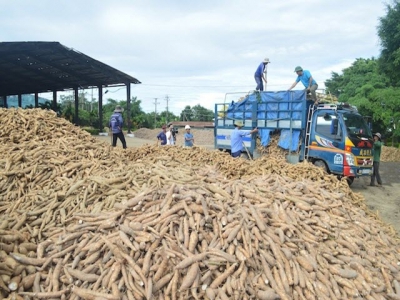China sharply reduced imports of Vietnamese cassava, increased imports from Thailand

In recent months, China has cut imports of cassava from Vietnam, while increasing imports from Thailand and Indonesia. This causes many difficulties for Vietnamese cassava factories.
Since the beginning of the year, exports of cassava products have increased sharply in volume and value. Source: Internet
According to the General Department of Vietnam Customs, in the first 15 days of August 2021, the export of cassava products reached 95.17 thousand tonnes, worth US$41.62 million, down 7.9% in volume and 0.9% in value compared to the last 15 days of July 2021; up 17.5% in volume and 41.4% in value from the same period last year.
From the beginning of the year to August 15, 2021, exports of cassava products reached 1.86 million tonnes, worth US$725.99 million, up 12.1% in volume and 26.4% in value over the same period in 2020.
The problem of exporting cassava products from the beginning of the year until now is the decrease in the export of cassava to the Chinese market.
The Agency of Foreign Trade said that in recent months, China has tended to reduce imports of cassava from Vietnam, while increasing imports from Thailand and Indonesia. This shows Vietnam's cassava is facing strong competition in the Chinese market.
"The export of cassava is low because China's demand is still slow. Consumption of the Chinese market tends to decrease, causing many problems for Vietnamese cassava factories," the representative of the Agency of Foreign Trade said.
According to statistics from China Customs, in the first half of the year, China imported 1.73 million tonnes of cassava (HS code 11081400), worth US$816.41 million, up 16.5% in volume and 35% in value over the same period in 2020. China mainly imports from Thailand, Vietnam, Indonesia, Laos, and Cambodia.
Thailand is the largest market supplying cassava to China with 1.28 million tonnes, worth US$613.11 million, up 54% in volume and 75.5% in value over the same period in 2020.
Vietnam is the second-largest market supplying cassava to China, with 252.6 thousand tonnes, worth US$114.95 million, down 58.2% in volume and 51.4% in value compared to the same period in 2020.
“Vietnam's market share of cassava in China's total imports in the first half of 2021 accounted for 14.6%, down sharply from 40.6% in the same period in the year before; while Thailand's cassava market share accounted for 74.1%, a sharp increase compared to 56% in the same period in 2020,” a representative of the Agency of Foreign Trade said.
In the domestic market, from the beginning of August up to now, the price of raw cassava in different regions has not changed much. Production plants in Tay Ninh are still closed, and the supply of cassava is scarce due to social distancing. Meanwhile, the prolonged intense heat caused many newly planted cassava areas in the central and Central Highlands regions to wither or die.
The cassava plant is in the process of developing stem and leaves, accumulating starch, so if the disease continues to spread, it will greatly affect the flour of the tubers later. The agricultural sector recommends that people enhance care, weeding, and fertilising to help plants grow well, resist leaf mosaic disease and limit the impact on productivity.
In Binh Dinh, cassava leaf mosaic disease has spread in many localities in the province, reducing the yield and quality of cassava roots. The total area of cassava cultivation of farmers in Binh Dinh in both winter-spring and summer-autumn crops is more than 10,000 hectares. Due to the prolonged hot weather, leaf mosaic disease makes cassava plants barren. In addition, thriving insects are also the cause of widespread disease spread.
In Phu Yen, the province has 16,447 hectares of cassava infected with mosaic virus disease. Song Hinh district has 6,000 hectares of diseased cassava, Dong Xuan 4,250 hectares, Son Hoa 4,420 hectares, Tay Hoa 1,750 hectares, Phu Hoa 25 hectares and Tuy An 2 hectares. The cassava area lightly infected from 5-15% is about 2,900 hectares; the average infected area from 15-30% is more than 6,100 hectares and nearly 7,400 hectares of cassava are very seriously infected with the disease rate from 50-100%.
Related news
 Increasing demands for Vietnamese dragon fruit in foreign market
Increasing demands for Vietnamese dragon fruit in foreign market Vietnam's dragon fruit industry has faced many challenges from production to consumption as a result of the Covid-19 pandemic
 Code for growing area and packing facility helps fruits and vegetables reaching further
Code for growing area and packing facility helps fruits and vegetables reaching further Expanding the issuance of code for growing area and packing facility in recent years help Vietnam’s fruits and vegetables holding many important markets
 Mangoes, guava and mangosteen imported from Vietnam into the EU grow sharply
Mangoes, guava and mangosteen imported from Vietnam into the EU grow sharply Vietnam is the 31st biggest supplier of mangoes, guava and mangosteen for the EU, with the proportion is just 0.4% of the gross imported amount of the EU.